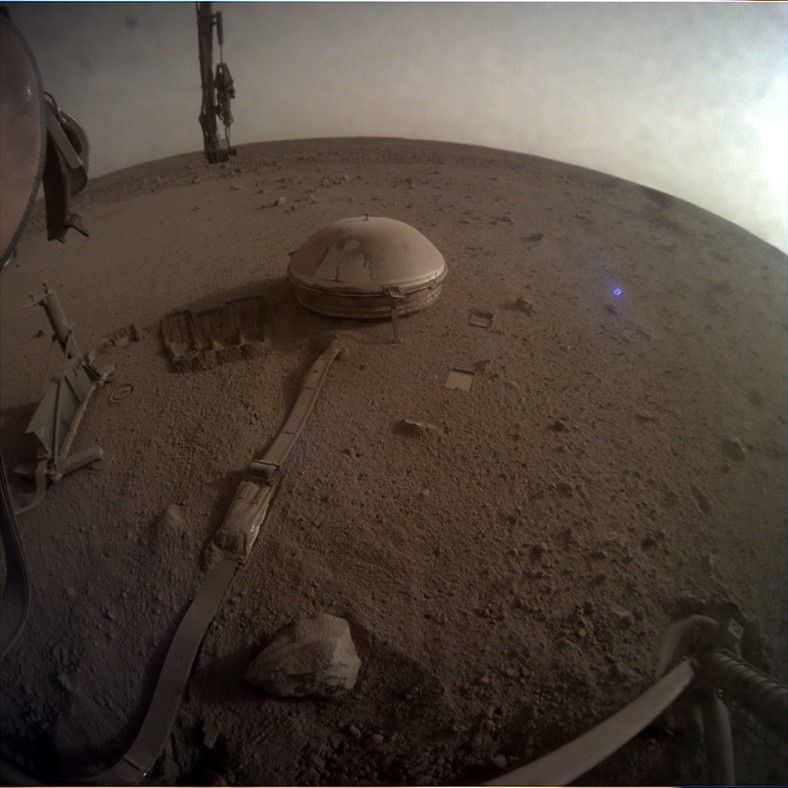
[ad_1]
 |
Back in May, we wrote about NASA’s InSight Mars lander approaching its final days. Per Paul Byrne on Twitter, it appears InSight has sent its final set of images home.
The InSight Mars lander (short for Interior Exploration using Seismic Investigations, Geodesy and Heat Transport) has been on Mars since November 26, 2018. In the subsequent years, the InSight team has used the lander’s onboard instruments to study Mars’ interior structure and existence, including measuring the Red planet’s seismology and heat flow. The lander’s seismometer has recorded more than 1,300 marsquakes, with the largest measuring a magnitude of 5.
Mars is a hostile and dusty work environment. InSight’s solar panels can no longer generate enough electricity as they’re too dusty. Plus, Mars is headed into its dustier season. As of May, the lander was operating at about 10% of its original power, able to perform measurements and send data for just 10 minutes per Martial day (sol). The nearly 30-member team had hoped for a passing whirlwind to help remove some of the dust from InSight, as has happened with other Mars missions like the Spirit and Opportunity rovers. However, no such luck.
 |
|
Not a functional slider above. ‘Using the camera on its robotic arm, NASA’s InSight lander took these selfies on Dec. 6, 2018 – just 10 days after touchdown on Mars – and April 24, 2022. A thick layer of dust can be seen on the lander and its solar panels in the latter image.’ Credits: NASA/JPL-Caltech. Click here to download a high-res version. |
As of November 1, the team had begun its final critical operations. At that time, it was expected that InSight would power down for good within the next few weeks. Any day now, the lander will go permanently silent.
The most important final steps of the InSight mission are to store the treasure trove of data it collected. The lander has uncovered important details about Mars’ interior layers, liquid core, and surprising evidence of a mostly extinct magnetic field. InSight has also collected significant data about the weather on Mars, at least around the landing site, Elysian Planitia. Plus, InSight recorded seismic data for more than 1,300 marsquakes. InSight’s seismometer, built by France’s Centre National d’Etudes Spatiales (CNES), also measured meteoroid impacts. The data about how those shockwaves traveled through Mars’ interior offered key insights into its present structure and how the planet formed over a long period.
 |
| ‘NASA’s InSight Mars lander acquired this image using its robotic arm-mounted, Instrument Deployment Camera (IDC).’ This image was captured on November 13, 2022 (sol 1409).
Credits: NASA/JPL-Caltech |
The data from InSight will be shared with scientists worldwide, helping unlock mysteries about Mars. Unfortunately, most instruments were already powered down earlier this summer, as the team had to prioritize power for the seismometer. Nonetheless, the amount of information that InSight has sent back to Earth is tremendous.
NASA will officially declare the InSight mission over once the lander misses two consecutive communication sessions with the Mars Relay Network spacecraft orbiting Mars, assuming the missed communication is due to the lander itself. After that, NASA’s Deep Space Network will keep its ears open, just in case of a miracle.
There will be no attempt to save InSight. A mission-saving weather event could occur, but it’s exceedingly unlikely. The mission will almost certainly conclude in the coming days and weeks, but its legacy is an amazing collection of data and images. The InSight mission was planned for just a year, and it managed to survive on Mars for four years.
[ad_2]
Source link








